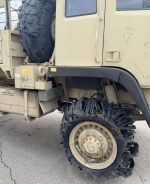charlieaarons
Explorer
You have just stated the reason why ANYONE, no matter what size tires, should have both a mounted spare and second spare, if they’re going to use their “expedition vehicle” for the intended purpose. Unmounted is perfectly ok if one has 2 or 3 piece wheels and the necessary tools and skip for field R&R. Otherwise, the second spare should be mounted.
Let’s say YOU , having a vehicle with large high capacity LT tires (like 37 or 40x12.5-17 or 18) are driving the Alcan, the Dalton Hwy (haul road to Arctic Ocean) or even just a week of exploring in SE Utah. You have a tire calamity unfixable with your plug kit (rip in sidewall). You mount your spare. You’re deep in the LaSal Mts, or perhaps on some multi-day track in Canyonlands.
So you mount your spare. You suddenly realize another unfixable tire problem is a mobility kill. What do you do?
Most people if in Utah would turn around and head for Moab. On the Dalton, turn around and head back to Fairbanks, losing your chance to ever see the Brooks Range and arctic slope. On the Alcan, hope you make it to Whitehorse, Delta Junction, Watson Lake or Ft St John or Dawson Creek. Although Ft Nelson has grown up some.
OTOH, with a second spare and the tools and skill to mount it, you just keep going. It DOESN’T MATTER what size tire or LT vs MPT.
And BTW, 4000+ capacity LT tires aren’t found at every average tire place either. Even in lower 48, you might be stuck for a couple of days waiting for delivery.
In the old days, when guys like Tom Shepard were doing real expeditions crossing the Sahara, they’d have 3-4 same mfg vehicles(Land Rovers or Landcruisers) all with 7.50R16 Michelin XS on interchangeable wheels. Then they could borrow spares from each other.
Let’s say YOU , having a vehicle with large high capacity LT tires (like 37 or 40x12.5-17 or 18) are driving the Alcan, the Dalton Hwy (haul road to Arctic Ocean) or even just a week of exploring in SE Utah. You have a tire calamity unfixable with your plug kit (rip in sidewall). You mount your spare. You’re deep in the LaSal Mts, or perhaps on some multi-day track in Canyonlands.
So you mount your spare. You suddenly realize another unfixable tire problem is a mobility kill. What do you do?
Most people if in Utah would turn around and head for Moab. On the Dalton, turn around and head back to Fairbanks, losing your chance to ever see the Brooks Range and arctic slope. On the Alcan, hope you make it to Whitehorse, Delta Junction, Watson Lake or Ft St John or Dawson Creek. Although Ft Nelson has grown up some.
OTOH, with a second spare and the tools and skill to mount it, you just keep going. It DOESN’T MATTER what size tire or LT vs MPT.
And BTW, 4000+ capacity LT tires aren’t found at every average tire place either. Even in lower 48, you might be stuck for a couple of days waiting for delivery.
In the old days, when guys like Tom Shepard were doing real expeditions crossing the Sahara, they’d have 3-4 same mfg vehicles(Land Rovers or Landcruisers) all with 7.50R16 Michelin XS on interchangeable wheels. Then they could borrow spares from each other.

